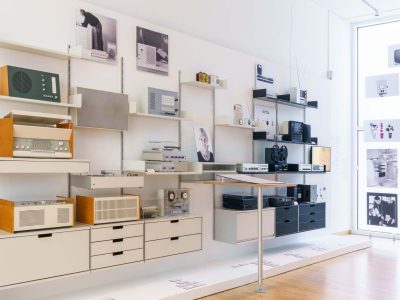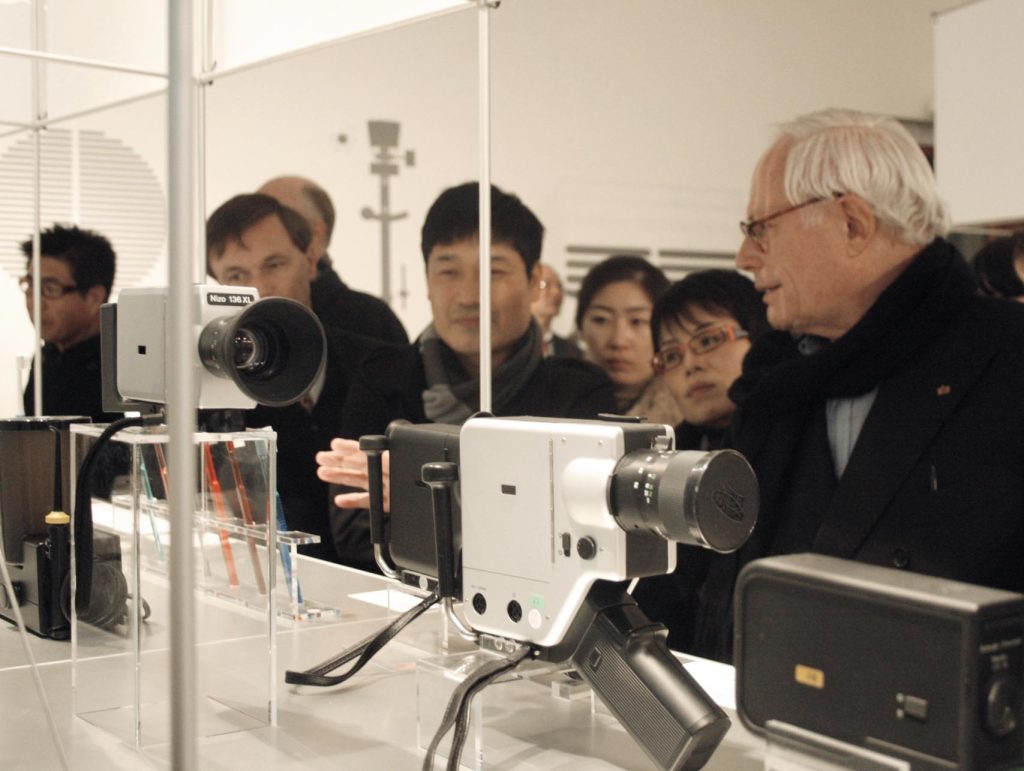
Dieter Rams with visitors at the Less and More exhibition in Seoul in December 2010
© rams foundation
Braun Design in Asia
Klaus Klemp
When considering Braun’s relationship with Asia, it immediately becomes clear that the German company has oriented itself internationally from the very outset. This is true both in terms of its products and sales markets. The Volksempfänger radio, with its short range, was followed in 1933 by the Fernempfangs-Vorsatz for European reception. The T 1000 world receiver of 1963, with which all short-wave transmitters worldwide could be received, became legendary.
The founder, Max Braun, a successful technician at AEG in Berlin who moved to the Rhine-Main region for the sake of love, sets up his own business in Frankfurt a.M. in 1921 with just one product and a handful of employees. His new type of quick connector for broken transmission belts quickly became a bestseller and already in that same year at the Frankfurt Autumn Fair he found an English trading partner in Camp & Watson, who paid in British pounds and so rescued him from the German hyperinflation of 1923. Within just a few years, branches opened in the Netherlands, Switzerland, Spain, Tunisia and Morocco. A factory of his own was built in England with the first phonographs, while France became the most important export country for Max Braun’s record player arms.
In 1937, Braun formed part of the German contribution to the world’s fair in Paris. The company presented its own stand at the International Exhibition in Thessaloniki two years before and is promptly awarded a Grand Prix for the battery powered Koffersuper BSK 36.
Erwin and Artur Braun, the company’s next generation, continued to take an international approach after the Second World War. The USA became the most attractive market. In 1954, the company successfully signed a licensing agreement for razors with the US manufacturer Ronson for a phenomenal sum of 10 million dollars. This was the largest German foreign business agreement of the post-war period. Erwin Braun later described it as his greatest youthful sin, since Braun was not allowed to sell under its own brand name on the American market until 1975. They could also not really do much business there with household appliances and hi-fi systems. The competition was fierce, technically at least equal, and usually cheaper. Exports are primarily to Northern, Western and Southern Europe, but also to Poland and Yugoslavia. In the 1967/68 business year, foreign sales accounted for fifty-five percent of the total sales.
Japan
In 1959, Braun was represented for the first time at a German travelling exhibition at the Japanese Council of Industrial Design in Japan and again there in 1965 with the entire programme. In 1973, Braun was invited to present itself extensively at the ICSID Congress in Kyoto. Fritz Eichler, Dieter Rams and Wolfgang Schmittel attended.
Since the sixtant, shavers have been the financial backbone of the company and Japan quickly becomes the largest overseas market. From as early as the 1964/65 business year, Braun has had a market share of twenty percent there. At times it even is the market leader. With its first sixtant of 1962, as well as its successor models, Braun has produced appliances that are as elegant as they are reduced in form and therefore perfectly compatible with traditional Japanese aesthetics. South Korea and China did not play a role at that time, but this was to change significantly in the 1990s. Since 2020, the new shaver known as pocket, designed in Kronberg, has been manufactured solely by Xiaomi Mijia in China and distributed there and from there.
In another area, however, Japan contributed to the elimination of the audio sector, which was so important for Braun’s identity. The Braun atelier hi-fi systems, despite being produced in Japan and Taiwan for financial reasons, were no longer able to compete with Sony, Panasonic, Sharp or Onkyo in terms of price and technology. In 1991, Braun’s American management took the decision to close down the loss-making product line. Today, only 30 years later, a new attempt is being made at an audio product line at Braun in the form of three smart loudspeakers.
Two Braun designers were, or are, particularly influenced by traditional Japanese aesthetics. In the first instance, there was Gerd A. Müller, who had already familiarised himself with the country through books, as an enthusiastic cook through Japanese cuisine and then also by way of trips to Japan. And then came Dieter Rams. At the ICSID Congress in Kyoto in 1973, he had the opportunity of providing an extensive presentation of Braun design together with Wolfgang Schmittel and Fritz Eichler. The itinerary for this event gave him with an invaluable insight into traditional Japanese architecture and aesthetics. Like many other German representatives of modernist design, such as Hermann Muthesius, Bruno Taut or Walter Gropius, he regarded it and European modernism as kindred spirits. This enthusiasm can still be seen today in the garden of the Rams’ home in Kronberg, which was created in 1970.
Three decades later, in 2005, Dieter Rams exhibited his work in the Kennin Temple in Kyoto, which was organised by Miki Shimokawa. For Rams it remains his most memorable exhibition in Asia on account of the historic architecture.
Dieter Rams on a stroll in the district of the Kiyomizu temple in Kyoto 1973
© rams foundation
From left to right: Wolfgang Schmittel, Dieter Rams, n.n., Fritz Eichler infront of the Kiyomizu temple, Kyoto on the occasion of the ICSID conference,1973
© rams foundation
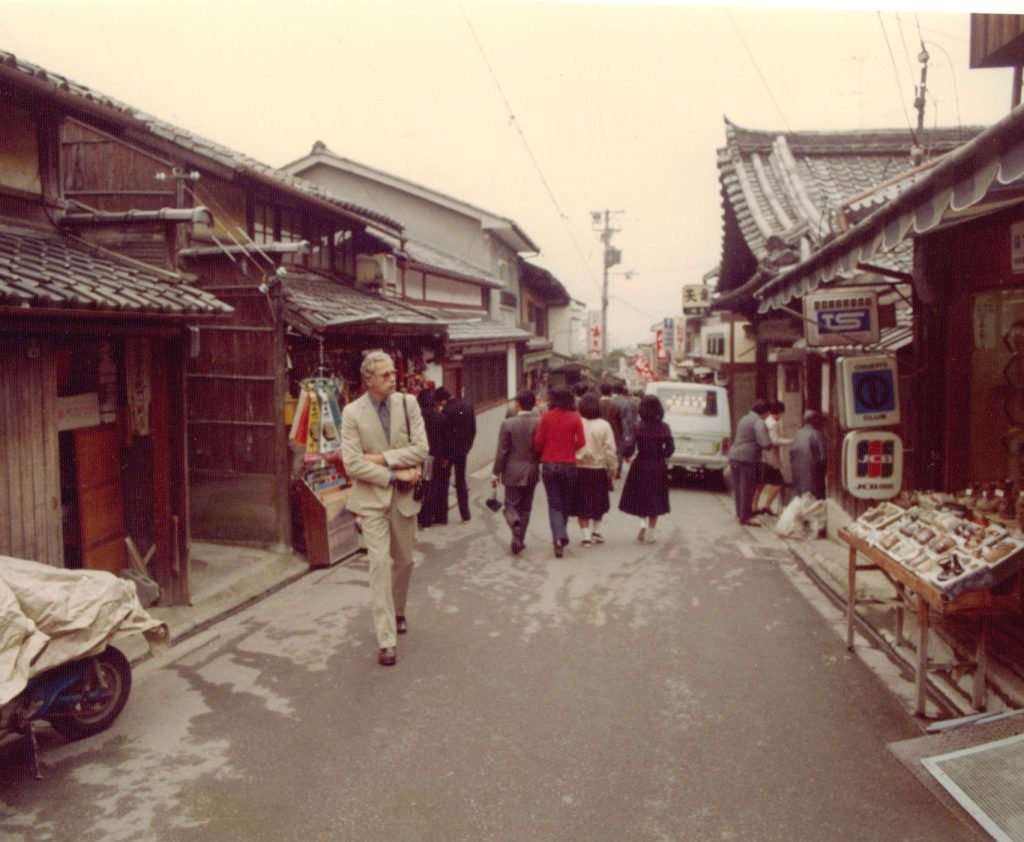
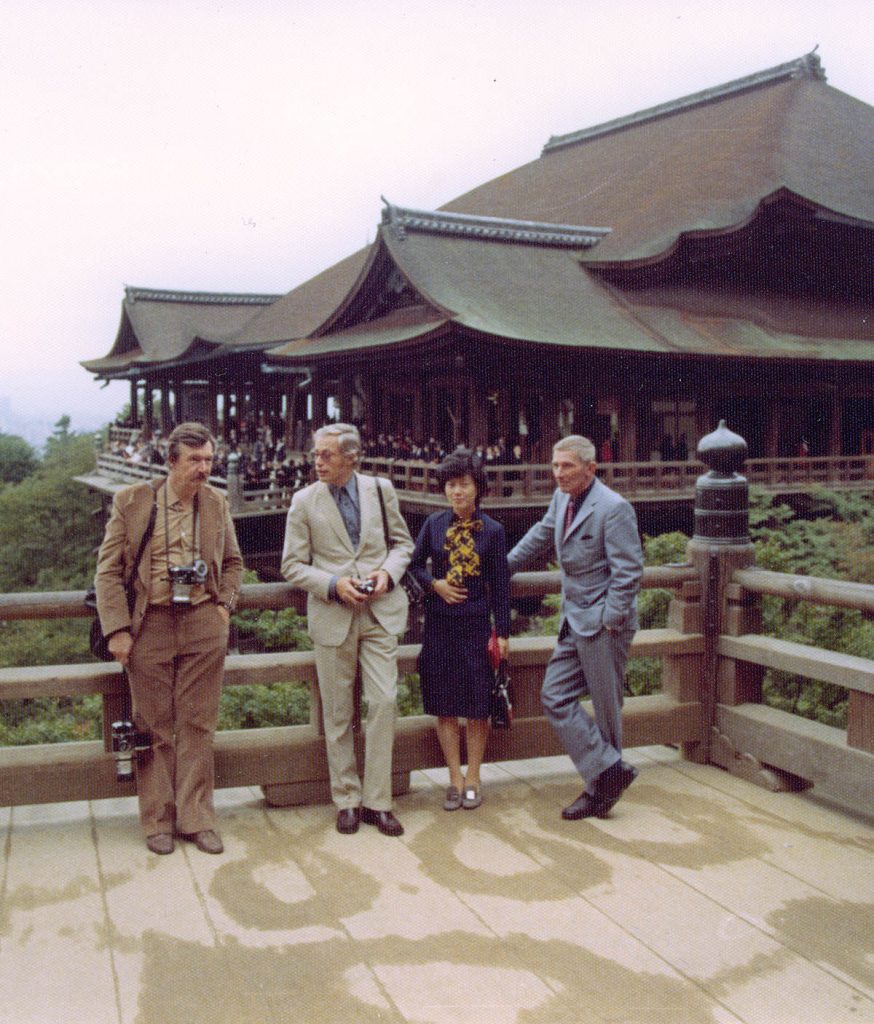
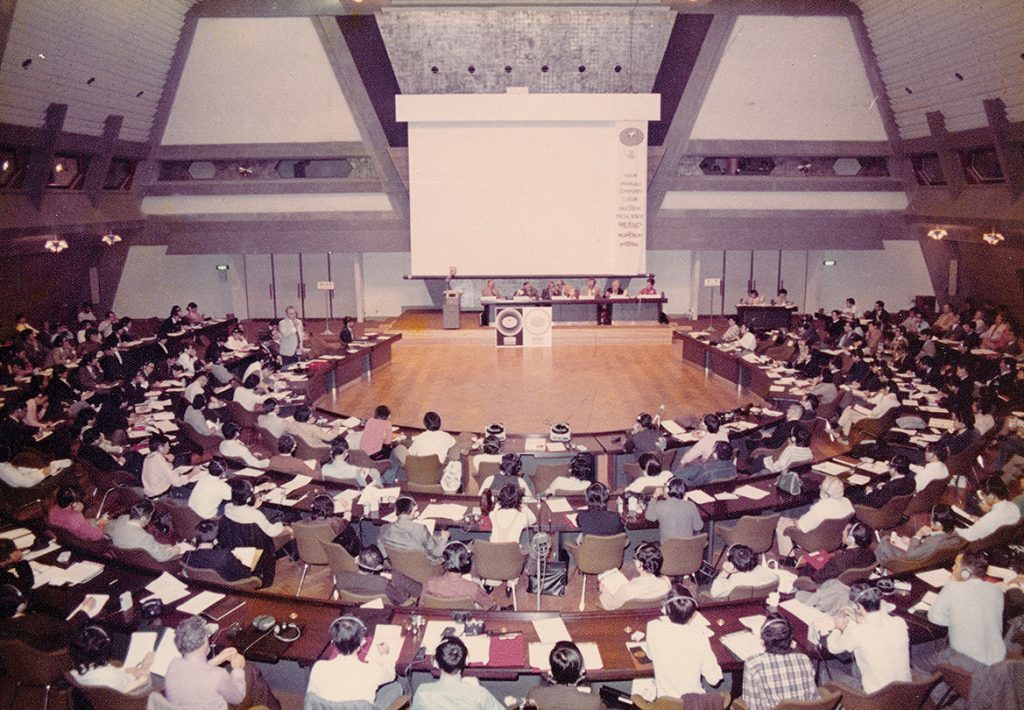
Conference hall of the ICSID meeting, Kyoto, 1973
© rams foundation
Less and More
What the German curator had imagined as a simple implementation of a small exhibition grew increasingly larger and became one of the museum’s main exhibitions. In Japan, such decisions cannot be made directly between curators, nor between directors. Instead, major institutions are involved and a competition is first held with other project proposals. So, one has to draw up concepts, exhibition outlines and budgets, approach committees and bring an assurance of success. And above all, it must always be on time. However, if the project then wins the bid, it gains full support and petty concerns or financial reticence consequently fall away. Nevertheless, everything has to be planned meticulously and to the day exactly, at least one year in advance. The future is not left to chance here.
The catalogue was ambitiously planned to comprise 400 pages. After two years of research, it was time to write. Further authors from Germany and Japan had been invited and were supervised by Keiko there and by me here. All the objects were photographed from every angle by a talented graduate of a German design school. One would think that that would have been good enough. Not for the Japanese. When the exhibits arrived in Osaka, photographer Koichi Okuwaki staged everything once again and in a completely new way. And that proved to be the more convincing concept. An assistant photographer was allowed to take certain additional photos. Our German photos were barely good enough for the dimensional illustrations. Ultimately, the catalogue comprised not only 400, but 808 pages that consisted of different kinds of paper, with a cover made of white plastic and a grey slipcase. It turned into a graphic masterpiece that would later be awarded a Gold Cube by TDC New York.
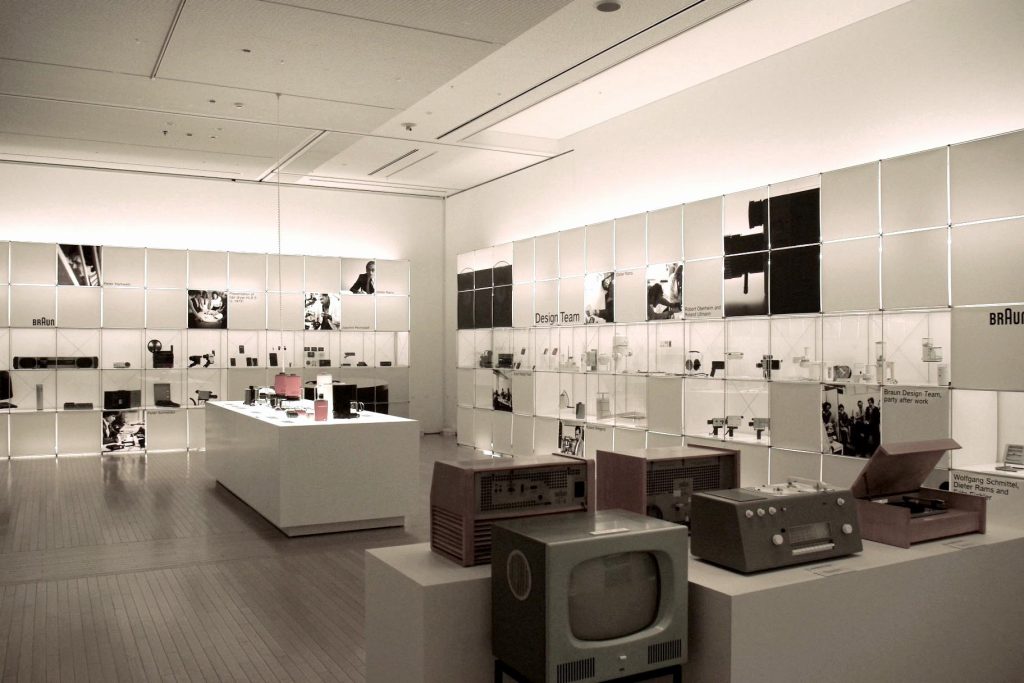
1st venue of the Less and More exhibition in Osaka, 2008
© rams foundation
Osaka
On 14 November 2008, the exhibition opened in Osaka. Dieter and Ingeborg Rams, the Foundation Manager Britte Siepenkothen and I arrived. Important Suntory managers spoke. However, the next day a symposium with Dieter Rams, Toshiyuki Kita and Naoto Fukasawa took place, which was organised by the museum. In front of a sold-out house (the museum’s IMAX cinema), meaning an audience of almost 500, the three designers made an impressive plea for a product design that was dedicated to the needs of the user and not to stardom and marketing design. Fukasawa, for example, said that we had to redesign objects ‘that fit in with society’. The mainly young visitors to the event responded with sustained applause.

Cover of the magazine Design+Design 86, 2008/09 with the poster motif of the exhibition Less and More in Osaka
© Hartmut Jatzke-Wigand
Tokyo
The second exhibition stop is Tokyo with the Fuchu Art Museum. This is a kind of district museum, although one should be aware that Tokyo is made up of different cities, which are often separated by parks and can be quite distinctive in character. Each of these cities also strives for its own cultural identity. These efforts also have very positive effects in a big city. Thus, this ‘district museum’ in western Tokyo, which opened in 2000, would also be the main museum in a smaller city. In May 2009, Dieter Rams and Britte Siepenkothen travelled to Tokyo for the opening. On 21 May, the exhibition construction was inspected, followed by an interview with the BBC. In the early evening, the studios of Naoto Fukasawa Design were visited. The exhibition opening was on 22 May from 3 p.m. to 5 p.m., while the opening party ran from 6 p.m. to 8 p.m. in a Japanese restaurant.
A symposium at Tokyo’s Musashino Art University, which was held one day after the exhibition opening at the Fuchu Art Museum, explored the question of how design might develop in the future. Dieter Rams, with a specially written manifesto that, above all, called on design students to be more courageous and responsible. Alongside him was the elder statesman of Japanese product design, Prof. Shutaro Mukai, who highlighted the historically close ties between his country and Germany. A prominent representative of the younger generation, Taku Satoh, also made an emphatic plea for designers to assume a new level of social compatibility in their work. He argued that the primary aspects of design are not marketing and economics, but rather the interests of users, and ultimately an aesthetic culture of everyday life. The 250, mostly young, visitors to the event agreed with this view in an extensive discussion and subsequently celebrated Dieter Rams as the founding father of their own ‘iPod identity’. This shift in designers’ interests, from marketing to user orientation, was particularly evident in Japan.
The exhibition would have continued to Tokyo and it was intended that it be presented finally in Frankfurt. However, the director of the London Design Museum, Deyan Sudjic, had already arrived in Osaka during the setting up of the show. He proposed to take the exhibition to London. What a thought. Which is what then also happened.

Dieter Rams and Shigehiko Honda surrounded by students after the symposium at Tokyo's Musashino Art University on 23 May 2009
© rams foundation
Seoul
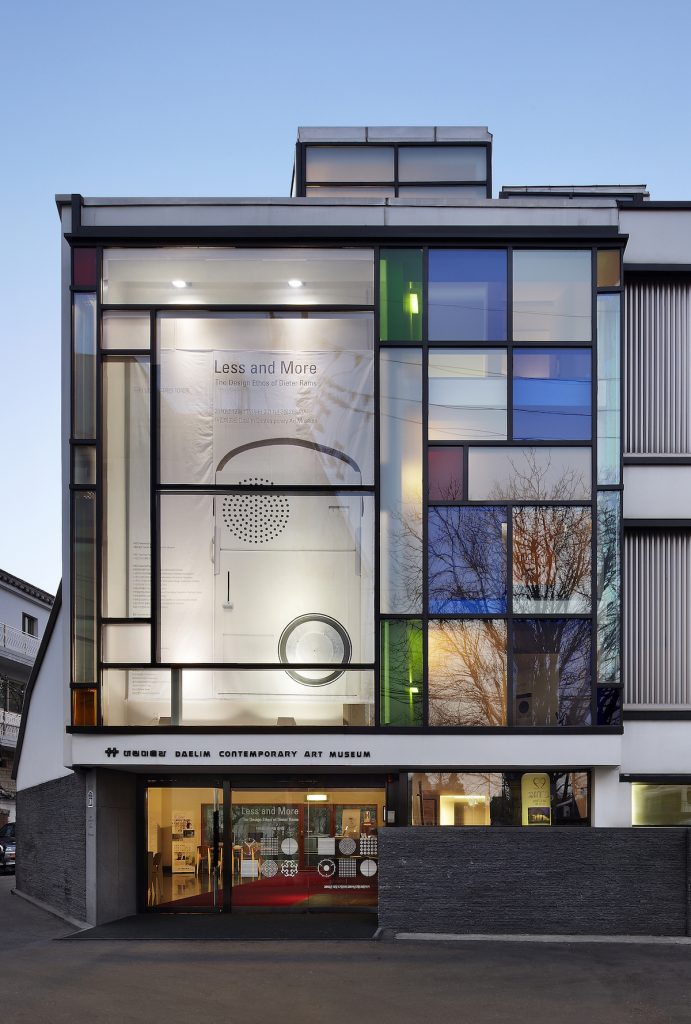


Less and More exhibition at the Daelim Museum in Seoul, 2010/11
© Daelim Cultural Foundation
China
There were also others who introduced Braun design to Asia. The still fairly new China Museum of Design, which was designed by architects Álvaro Siza and Carlos Castanheira in Hangzhou and lies 190 km south-southwest of Shanghai, is presenting the exhibition A Face of Second Modernity: The Braun Design 1951-1967 in the winter of 2019/2020. Also participating was the archive of the HfG Ulm, the Berlin collector Werner Ettel, and the Hamburg collectors and publishers of the magazine design+design Jo Klatt and Hartmut Jatzke-Wigand. The museum, which already had a large Bauhaus collection, purchased abundantly from the German collectors. An attempt was being made to gain a little interpretive sovereignty over German design for China.
Braun in Asia
Extended version of the book contribution of the same name in: Alwin und Dieter Zenkel (eds.): Braun erleben. Stuttgart 2024.
More contributions
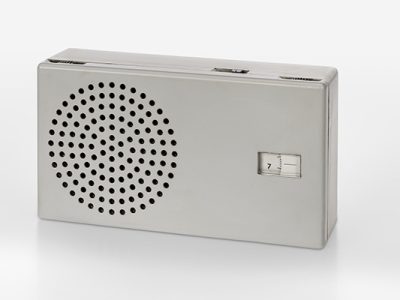
Rams Design for Braun
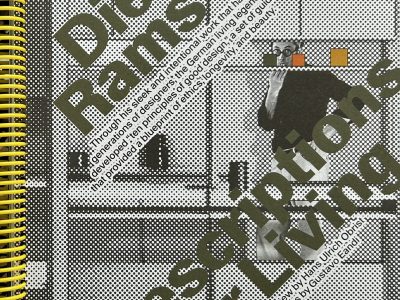
Interview Hans Ulrich Obrist
